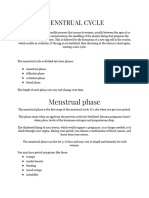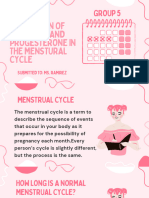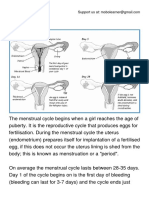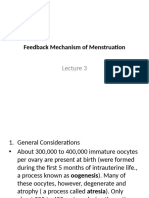0 ratings0% found this document useful (0 votes)
57 viewsThemenstrualcycle 120606211927 Phpapp02
Themenstrualcycle 120606211927 Phpapp02
Uploaded by
Ludy LynThe menstrual cycle is controlled by hormones and typically lasts 28 days. At puberty, a female's reproductive system matures and she begins menstruating monthly. During the cycle, the ovaries release an egg (ovulation) around day 14 under the influence of hormones. If the egg is not fertilized, the uterine lining breaks down and is shed, causing menstruation. This cyclical process prepares the body for potential pregnancy each month until menopause.
Copyright:
© All Rights Reserved
Available Formats
Download as PPT, PDF, TXT or read online from Scribd
Themenstrualcycle 120606211927 Phpapp02
Themenstrualcycle 120606211927 Phpapp02
Uploaded by
Ludy Lyn0 ratings0% found this document useful (0 votes)
57 views16 pagesThe menstrual cycle is controlled by hormones and typically lasts 28 days. At puberty, a female's reproductive system matures and she begins menstruating monthly. During the cycle, the ovaries release an egg (ovulation) around day 14 under the influence of hormones. If the egg is not fertilized, the uterine lining breaks down and is shed, causing menstruation. This cyclical process prepares the body for potential pregnancy each month until menopause.
Original Title
themenstrualcycle-120606211927-phpapp02 (1).ppt
Copyright
© © All Rights Reserved
Available Formats
PPT, PDF, TXT or read online from Scribd
Share this document
Did you find this document useful?
Is this content inappropriate?
The menstrual cycle is controlled by hormones and typically lasts 28 days. At puberty, a female's reproductive system matures and she begins menstruating monthly. During the cycle, the ovaries release an egg (ovulation) around day 14 under the influence of hormones. If the egg is not fertilized, the uterine lining breaks down and is shed, causing menstruation. This cyclical process prepares the body for potential pregnancy each month until menopause.
Copyright:
© All Rights Reserved
Available Formats
Download as PPT, PDF, TXT or read online from Scribd
Download as ppt, pdf, or txt
0 ratings0% found this document useful (0 votes)
57 views16 pagesThemenstrualcycle 120606211927 Phpapp02
Themenstrualcycle 120606211927 Phpapp02
Uploaded by
Ludy LynThe menstrual cycle is controlled by hormones and typically lasts 28 days. At puberty, a female's reproductive system matures and she begins menstruating monthly. During the cycle, the ovaries release an egg (ovulation) around day 14 under the influence of hormones. If the egg is not fertilized, the uterine lining breaks down and is shed, causing menstruation. This cyclical process prepares the body for potential pregnancy each month until menopause.
Copyright:
© All Rights Reserved
Available Formats
Download as PPT, PDF, TXT or read online from Scribd
Download as ppt, pdf, or txt
You are on page 1of 16
THE MENSTRUAL CYCLE
Candidate should be able to describe the menstrual cycle
When a female reaches puberty she usually
has a menstrual period every month.
The start of periods is known as menarche.
Menarche doesn't happen until all the parts of
a girl's reproductive system have matured and
are working together.
This event occurs until the woman reaches
menopause
This period is apart of a cyclical process
which prepares the woman's body for the
development of a fertilized egg.
The process is controlled by several
hormones.
What is a hormone?
A chemical substance produced by an
endocrine gland to coordinate one or more
specific processes in the body.
The process is controlled by several
hormones.
GONADOTROPIN-RELEASING HORMONE GnRH
FOLLICLE STIMULATING HORMONE FSH
LEUTENIZING HORMONE LH
LUTEOTROPPIC HORMONE
OESTROGEN
PROGESTERONE
Each month, the ovary releases an egg cell. It
travels down the fallopian tube towards the
uterus.
The egg matures when
FSH from the
pituitary gland
reaches the ovary.
The mature egg is
surrounded by a fluid
and a jacket of cells
known as the
Graafian follicle.
Graafian Folllicle
OVULATION
The mature Graafian follicle moves toward the
surface of the ovary and ruptures releasing
the egg(ovum) from the follicle and the ovary.
This process, ovulation occurs about the 14 th
day after the beginning of the menstrual
period.
When the ovum is released it enters the
oviduct and passes along the oviduct to the
uterus
After ovulation, the pituitary gland secretes
lutenizing hormone (LH).
LH changes the remains of the follicle into the
corpus luteum/yellow body.
Corpus luteum produces the hormone
progesterone.
Progesterone further thickens the uterus lining
and increases blood supply
If fertilization does occur the corpus luteum
enlarges and continues to produce progesterone.
The lining of the uterus thickens and blood
supply increases.
Progesterone also causes the breast to enlarge.
These are pregnancy changes, progesterone is
also known as the pregnancy hormone.
Both oestrogen and progesterone slow down FSH
production when their concentrations become
high. Thus no more eggs develop. *negative
feedback *
If fertilization does not occur the corpus
luteum degenerates to ordinary ovary tissue
and the progesterone level falls.
The lining of the uterus breaks down and the
egg dies.
Lining along with blood passes out the vagina
as the menstrual period.
Cycle continues with increased FSH production
and egg development.
Cycle lasts approximately 28days
Normal Menstrual Cycle
What is the mean duration of the MC?
Mean 28 days (only 15% of )
Range 21-35
What is the average duration of menses?
3-8 days
What is the normal estimated blood loss?
Approximately 30 ml
When does ovulation occur?
Usually day 14
36 hrs after the onset of mid-cycle LH surge
Menstrual Cramps
Menstrual cramps are pains in the abdominal
(belly) and pelvic areas that are experienced by
a woman as a result of her menstrual period.
Menstrual cramps can range from mild to quite
severe. Mild menstrual cramps may be barely
noticeable and of short duration - sometimes felt
just as a sense of light heaviness in the belly.
Severe menstrual cramps can be so painful that
they interfere with a woman's regular activities
for several days.
What causes menstrual cramps
When the old uterine lining begins to break
down, molecular compounds called
prostaglandins are released. These compounds
cause the muscles of the uterus to contract.
When the uterine muscles contract, they
constrict the blood supply to the endometrium.
This contraction blocks the delivery of oxygen to
the tissue of the endometrium which, in turn,
breaks down and dies. After the death of this
tissue, the uterine contractions literally squeeze
the old endometrial tissue through the cervix
and out of the body by way of the vagina.
You might also like
- Sex God SecretsDocument123 pagesSex God SecretsKhamiss Khouya55% (20)
- Science Imporatance of 5 RsDocument5 pagesScience Imporatance of 5 RsLudy Lyn81% (21)
- Feedback Mechanisms and Menstrual CycleDocument90 pagesFeedback Mechanisms and Menstrual CycleThird WillowNo ratings yet
- Menstrual CycleDocument24 pagesMenstrual Cyclemeez rameezNo ratings yet
- Menstruation NotesDocument6 pagesMenstruation NotesAudrie Allyson GabalesNo ratings yet
- What Causes Menstrual Cycle Irregularities?Document6 pagesWhat Causes Menstrual Cycle Irregularities?LioraNo ratings yet
- Hormonal CycleDocument20 pagesHormonal CycleGuna100% (2)
- Menstrual Cycle PhysiologyDocument3 pagesMenstrual Cycle PhysiologyDeadful Loop AndirNo ratings yet
- Menstrual CycleDocument4 pagesMenstrual CyclemochidundunNo ratings yet
- g12 menstrualDocument8 pagesg12 menstruallebesethato932No ratings yet
- CycleDocument2 pagesCycleChinchay Guinto100% (1)
- Menstrual Cycle AutosavedDocument33 pagesMenstrual Cycle Autosavedნინო ღვინაძე100% (1)
- Pink Organic Women's Health PresentationDocument12 pagesPink Organic Women's Health PresentationKathlyn VillarNo ratings yet
- Topic-Menstural Cycle: Name-Divya Sharma Roll No-8 & Bharti Kotwal Roll No-7Document15 pagesTopic-Menstural Cycle: Name-Divya Sharma Roll No-8 & Bharti Kotwal Roll No-7chanderNo ratings yet
- Menstrual CycleDocument6 pagesMenstrual CycleAthirah BidinNo ratings yet
- Menstrual CycleDocument4 pagesMenstrual CyclemochidundunNo ratings yet
- Menstrual Cycle. Pptx by Uzma kouserDocument15 pagesMenstrual Cycle. Pptx by Uzma kousershaiksam083No ratings yet
- S10Q3M2 - The Menstrual Cycle PDFDocument46 pagesS10Q3M2 - The Menstrual Cycle PDFLorainne CasnoNo ratings yet
- Reproductive Cycles in MammalsDocument9 pagesReproductive Cycles in MammalsSeemal shahidNo ratings yet
- TP Anglais FinalDocument7 pagesTP Anglais FinalGift NgongoNo ratings yet
- Menstrual CycleDocument29 pagesMenstrual CycleLiezel CauilanNo ratings yet
- The Menstrual Cycle PDFDocument6 pagesThe Menstrual Cycle PDFPerry Sin100% (2)
- Menstrual CycleDocument6 pagesMenstrual Cyclebuhari rabiuNo ratings yet
- Hormonal Cycles: Presented By: Miss. M.K.Kaku Nursing TutorDocument23 pagesHormonal Cycles: Presented By: Miss. M.K.Kaku Nursing TutorKaku ManishaNo ratings yet
- Biology ProjectDocument21 pagesBiology Projectsiatiwari16No ratings yet
- Meenal BiologyDocument18 pagesMeenal BiologymansiNo ratings yet
- Unit 3 Module 1 The Menstrual CycleDocument20 pagesUnit 3 Module 1 The Menstrual CycleMARIANNE SORIANO100% (3)
- Menstrual Cycle Biology ProjectDocument4 pagesMenstrual Cycle Biology ProjectaddyNo ratings yet
- bio.docx (1)Document10 pagesbio.docx (1)samayajitbehera243No ratings yet
- Coordinated Functions of The Reproductive, Endocrine And2Document27 pagesCoordinated Functions of The Reproductive, Endocrine And2Second BooksNo ratings yet
- Final PPT-1 PDFDocument23 pagesFinal PPT-1 PDFsubiNo ratings yet
- Menstrual CycleDocument8 pagesMenstrual Cyclejeni antonyNo ratings yet
- The Menstrual Cycle TranskipDocument5 pagesThe Menstrual Cycle Transkiplen lehangNo ratings yet
- Sci Q3Document3 pagesSci Q3mypatchieeNo ratings yet
- Menstruation ProjectDocument13 pagesMenstruation Projectkeshu.ranjan26No ratings yet
- Menstrual Cycle and Hormones HDFHBFB DrygDocument10 pagesMenstrual Cycle and Hormones HDFHBFB DrygBxdhu DjxuhxNo ratings yet
- 3rd Quarter.1Document62 pages3rd Quarter.1balatayojeanmary8No ratings yet
- Processes of The Female Reproductive SystemDocument40 pagesProcesses of The Female Reproductive SystemPristine AlbayNo ratings yet
- Bio Investigatory ProjectDocument17 pagesBio Investigatory Projectsarmisthan09No ratings yet
- The Menstrual CycleDocument18 pagesThe Menstrual CycleSakshi Halve100% (1)
- The Menstrual CycleDocument12 pagesThe Menstrual CycleSheena DalguntasNo ratings yet
- MCN Cover To Cover ?Document247 pagesMCN Cover To Cover ?Elsid Nathaniel S. MartinNo ratings yet
- The Menstrual CycleDocument8 pagesThe Menstrual CycleTaelor FergusonNo ratings yet
- IntroDocument7 pagesIntroibrahim.21hm32No ratings yet
- Female Menstrual CycleDocument16 pagesFemale Menstrual Cycletrivens1302No ratings yet
- MCN Menstrual Cycle LatestDocument8 pagesMCN Menstrual Cycle LatestsophienNo ratings yet
- 2 Menstruation and DX Pregnancy MTPDocument53 pages2 Menstruation and DX Pregnancy MTPmeethsrivastavaNo ratings yet
- Female Physiology 1Document2 pagesFemale Physiology 1JayricDepalobosNo ratings yet
- The Menstrual Cycle: Yeovil Fertility UnitDocument5 pagesThe Menstrual Cycle: Yeovil Fertility Unitnoordin MukasaNo ratings yet
- Puberty Below: Role of HormonesDocument3 pagesPuberty Below: Role of HormonesCyril CauilanNo ratings yet
- Female Reproductive Hormones by Eness.n. KapembwaDocument11 pagesFemale Reproductive Hormones by Eness.n. KapembwansululukafwinaNo ratings yet
- Ncma Sir VDocument3 pagesNcma Sir VMilca DavidNo ratings yet
- Feedback MechanismDocument29 pagesFeedback MechanismJennie KimNo ratings yet
- Q3 Lesson 3 The Female Reproductive Feedback MechanismDocument27 pagesQ3 Lesson 3 The Female Reproductive Feedback Mechanismjademarco901No ratings yet
- Menstrual CycleDocument31 pagesMenstrual CycleCathy C DNo ratings yet
- Menstruation and FertilizationDocument54 pagesMenstruation and FertilizationJanaica JuanNo ratings yet
- Quarter 3 Science 10 Week 2Document10 pagesQuarter 3 Science 10 Week 2Monica Grace ManaloNo ratings yet
- Family Health 1Document20 pagesFamily Health 1Google MediaNo ratings yet
- Study Session 4 Hormonal Regulation of The Female Reproductive SystemDocument11 pagesStudy Session 4 Hormonal Regulation of The Female Reproductive SystemUMINAHNo ratings yet
- Menstrual Cycle in FemalesDocument2 pagesMenstrual Cycle in FemalesAnsuman priyadarshiNo ratings yet
- perimenopause Unlocked: Your Essential Guide to Thriving Through ChangeFrom Everandperimenopause Unlocked: Your Essential Guide to Thriving Through ChangeNo ratings yet
- School Calendar 2019 2020Document12 pagesSchool Calendar 2019 2020Ludy LynNo ratings yet
- Butterflies: Presented by Noelia Lazo Sunday, July 7, 2019Document8 pagesButterflies: Presented by Noelia Lazo Sunday, July 7, 2019Ludy LynNo ratings yet
- Reproduction in AnimalsDocument19 pagesReproduction in AnimalsLudy LynNo ratings yet
- Motion and Types of MotionDocument15 pagesMotion and Types of MotionLudy LynNo ratings yet
- By JashithDocument7 pagesBy JashithLudy LynNo ratings yet
- ConstellationDocument62 pagesConstellationLudy LynNo ratings yet
- Activity 6 Menstrual Cycle Bracelet 1Document3 pagesActivity 6 Menstrual Cycle Bracelet 1Ludy Lyn100% (1)
- Guidelines and Criteria For 2017 Brigada Eskwela Jingle Making ContestDocument5 pagesGuidelines and Criteria For 2017 Brigada Eskwela Jingle Making ContestLudy LynNo ratings yet
- Student Action Plan Against Bullying!: What You Can DoDocument4 pagesStudent Action Plan Against Bullying!: What You Can DoLudy LynNo ratings yet
- Science 5 LM Q1 Q4Document149 pagesScience 5 LM Q1 Q4Ludy Lyn100% (3)
- DLL - Science 5 - Q3 - W4Document4 pagesDLL - Science 5 - Q3 - W4Ludy Lyn80% (5)
- Evaluatingthecurriculum 150911162332 Lva1 App6891Document13 pagesEvaluatingthecurriculum 150911162332 Lva1 App6891Ludy LynNo ratings yet
- Solu BilityDocument14 pagesSolu BilityLudy LynNo ratings yet
- BirthdayDocument7 pagesBirthdayLudy Lyn50% (4)
- Classification of Materials According To PropertiesDocument10 pagesClassification of Materials According To PropertiesLudy LynNo ratings yet
- Science Proper Waste DisposalDocument7 pagesScience Proper Waste DisposalLudy Lyn100% (1)
- Female Reproductive Systems RatsDocument14 pagesFemale Reproductive Systems RatsReshana SimonNo ratings yet
- Histo Lec - Female Reproductive SystemDocument10 pagesHisto Lec - Female Reproductive SystemJuren LasagaNo ratings yet
- Artigo RSF - 8Document19 pagesArtigo RSF - 8Vivian Campos DamascenoNo ratings yet
- Case Study of Pregnancy Uterine Full-Term (PUFT)Document17 pagesCase Study of Pregnancy Uterine Full-Term (PUFT)carls burg a. resurreccion100% (1)
- Menstrual CycleDocument12 pagesMenstrual CycleRUSTOM JAKENo ratings yet
- 2.Gynaecology-Cyclic Changes in Cervix-Vagina.Document37 pages2.Gynaecology-Cyclic Changes in Cervix-Vagina.zekarias wondafrashNo ratings yet
- Reproductive SystemDocument49 pagesReproductive SystemAyro Business CenterNo ratings yet
- Menstrual PeriodDocument2 pagesMenstrual Periodapi-206847705No ratings yet
- Faktor Yang Mempengaruhi Kejadian Dismenorea Pada Remaja Putri Kelas X Di MAN Rantauprapat Tahun 2021 Rika Handayani1Document17 pagesFaktor Yang Mempengaruhi Kejadian Dismenorea Pada Remaja Putri Kelas X Di MAN Rantauprapat Tahun 2021 Rika Handayani1Rika HandayaniNo ratings yet
- Supports & Innervation of UterusDocument19 pagesSupports & Innervation of UterusDr. Janarthanan V100% (1)
- Science10 q3 Mod2 Week2 Menstrual-Cycle-Version-3Document24 pagesScience10 q3 Mod2 Week2 Menstrual-Cycle-Version-3nadia doropanNo ratings yet
- 2 - Gametogenesis and Female CyclesDocument31 pages2 - Gametogenesis and Female CyclesMax DanhNo ratings yet
- The Menstrual CycleDocument8 pagesThe Menstrual Cyclemarc0123456100% (1)
- Q3W2Document28 pagesQ3W2pjNo ratings yet
- UntitledDocument8 pagesUntitledPJ Manuel SuerteNo ratings yet
- (Doi 10.1002/ca.22472) A. K. Pahwa E. S. Siegelman L. A. Arya - Physical Examination of The Female Internal and External Genitalia With and Without Pelvic Organ Prolapse - A ReviewDocument9 pages(Doi 10.1002/ca.22472) A. K. Pahwa E. S. Siegelman L. A. Arya - Physical Examination of The Female Internal and External Genitalia With and Without Pelvic Organ Prolapse - A ReviewPedro Ayala DiazNo ratings yet
- Anatomy of Reproductive System: Zamroni, M.DDocument46 pagesAnatomy of Reproductive System: Zamroni, M.DgoentryNo ratings yet
- FEMM Charting Brochure (Bi-Fold)Document2 pagesFEMM Charting Brochure (Bi-Fold)teachingtashoilsNo ratings yet
- 1.female Reproductive SystemDocument52 pages1.female Reproductive SystemKhairul HananNo ratings yet
- Bag/Smf Obstetri & Ginekologi Laporan Jaga FK Unand/ Rsup Dr. M. Djamil Padang 25 Februari - 1maret 2021Document3 pagesBag/Smf Obstetri & Ginekologi Laporan Jaga FK Unand/ Rsup Dr. M. Djamil Padang 25 Februari - 1maret 2021muttaqin95No ratings yet
- About VaginaDocument13 pagesAbout VaginaRazend Muhd0% (1)
- Fmge DFX - WORKBOOK - GYNAECOLOGY 2024Document49 pagesFmge DFX - WORKBOOK - GYNAECOLOGY 2024vudayNo ratings yet
- Physiology of MenstruationDocument11 pagesPhysiology of MenstruationDavid CalaloNo ratings yet
- Q2 - First Summative TestDocument3 pagesQ2 - First Summative TestMilagros ReyesNo ratings yet
- Abnormal Development of Female Genital TractDocument69 pagesAbnormal Development of Female Genital TractJerry CreedNo ratings yet
- Activities For March 8 10 2023Document23 pagesActivities For March 8 10 2023Devorah Ulka ChavezNo ratings yet
- Endometrium in Surgical PathologyDocument129 pagesEndometrium in Surgical PathologyleartaNo ratings yet
- KKPMT IV B ICD 9 Female GenitaliaDocument31 pagesKKPMT IV B ICD 9 Female GenitaliaAldy SetyawanNo ratings yet
- Model of Secondary OocyteDocument7 pagesModel of Secondary Oocytejessarhodes0852No ratings yet










































































































